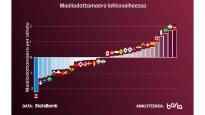The most talked-about statistic of these games seems to be again the number of goals. What the hell is expected goal and how is it calculated anyway? We try, especially with the help of videos, to answer these questions in this article.
Goal expectation, which comes from the English words expected goals, is often shortened to xG. In short, it tells the probability of the shot hitting the goal on a scale of 0–1. The higher the reading, the more likely the shot will hit the goal. This average finish is modeled with millions of shots.
What is the ground waiting for?
Actually, that’s what all the other statistics are for – to tell more about the game than just the result. Goal Expected is one of the best statistics for predicting success in the long run, because often creating better chances in the end also means you win more.
Each company has its own expected target modelling, so there is no single correct target expected reading and there can be some variation between the readings of different companies. However, in all modeling the position of the shot is the most important determining factor. For example, we use StatsBomb’s goal scorer, which is one of the most advanced models.
What other things affect the calculation of goal expectancy? Let’s go through them through videos:
– For example, the distance of the shot from the goal affects the goal expectation, so that the shots from close to the goal have the highest goal expectation. Correspondingly, the number of opponents between the ball and the goal and their placement are important. The height of the ball also matters. Finishes from the ground have higher goal expectations than, for example, finishes from the air, Miika Nuutinen states.
– Factors influencing the creation of the goal expectation are also the starting angle of the shot in relation to the goal, the positioning of the goalkeeper and the part of the body with which the goal is finished. For example, a finishing attempt clearly lowers the expected goal, Miika Nuutinen emphasizes.
– The best goal expectation models also take into account the effect of the play before the shot, such as a through pass or a cross. In practice, the previous pass is of great importance to the possibility of finishing. With what force or height does the pass come and from what position is it possible to finish after the pass, says Nuutinen.
When researching goal expectations, you can also come across other different statistics that refer to goal expectations. These are, for example, the expected goal assist (xA), or the expected goal after the shot (post-shot xG, xGOT). The expected goal assist calculates the probability that a goal will result from the pass.
The expected score after the shot, on the other hand, also evaluates the quality of the shot. It takes into account different variables after the shot and is primarily used to evaluate the goalkeeper’s performance. by Phil Foden in the example it was 0.89.
– The computer cannot accurately evaluate individual situations because it does not understand all the variables. However, it beats a human in the long run, because it evaluates every situation in the same way, and like a human does not know or understand the end result, says Nuutinen.
Is goal expectation a good measure of team superiority?
More important things happen in football than shots, and the goal scorer doesn’t take that into account. For example, a missed kick from an empty goal or own goals do not appear waiting, while a shot that VAR would have ruled out as offside can haunt the reading.
The goal expectation also does not understand the context if the other team scores two goals from “small positions” right at the start and keeps the opponent away from big positions for the rest of the time. So you can lose the expected goal, but be a clearly better team in relation to what the game calls you to do. This is emphasized above all in tournament-style competitions.
This is also why you should be very careful when declaring the superiority of teams based on expected goals in a tournament-style competition where the sample is very small.
In a tournament-style competition, the images of the game can be very different compared to a series-style competition. In one of the group stage matches, a draw or even a small loss may be enough for the team, in which case this has a big impact on the image of the game and thus on the goal expectation. A good example of this is Australia, who led every match they played in the group stage. However, according to the statistics, the country has the third worst goal difference.
– I recommend watching and following it, but I wouldn’t consider it as an absolute measure of superiority. As you can see from the graphic, Germany had the best goal difference in the entire group stage, and it certainly wasn’t the best team in the tournament, says Nuutinen.
Statistics are constantly developing, and there are already more advanced models than goal expectations that are able to measure, not only shots, but the effect of every play action on the probability of scoring a goal. The development in this area will certainly continue to accelerate and is contributing to the change of the game as well. Now the expectation of a goal has already contributed to shaping the starting position of the teams’ shots.
